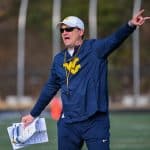
Morgantown, West Virginia Traditional, drop-back quarterbacks are a thing of the past in college football and it’s a real shame that Trey Lowe, former dual threat quarterback for the Mountaineers, was never given a real opportunity.
Trey Lowe was never been given a chance to shine in his young college football career, but he had all of the tools to be West Virginia’s next great quarterback and Neal Brown’s offense was built for a player like him. This has nothing to do with his race or the fact that West Virginia football’s greatest moments happened when the Mountaineers were led by black quarterbacks (Major Harris and Pat White), Trey Lowe is a dual threat quarterback.
In college football, it’s almost become a necessity to have a quarterback that can both throw and run to be successful. Most defensive schemes in college football are blitz heavy and this leads to the quarterback leaving the pocket often to evade increasingly fast defenders.
Not only does a dual threat quarterback give an offense the ability to escape defenders, they also create an additional threat that traditional pro style quarterbacks do not. This flexibility is particularly important for a team that struggles to block effectively like the Mountaineers did throughout last season. A dual-threat quarterback gives an offense the opportunity to make something out of nothing.
Back in 2008, Brown, who was only 27 years old at the time, was promoted to offensive coordinator at Troy,and he ran his then-signature offense called “NASCAR SPREAD.” His second year as an offensive coordinator, his team was 3rd in the nation, averaging 485.7 yard per game.
Brown perfected this offense under Tommy Tuberville at Texas Tech. In order to be run at its maximum effectiveness, Brown needed speed at every position – including the quarterback position – and there was a focus on players running to the line immediately after the play and quickly snapping the ball 8 seconds after the previous play and before the defense was ready. This 2010 version of the “NASCAR SPREAD” was ranked 15th in the country in total offense, 6th in passing and 72nd in rushing.
Why West Virginia’s offense struggled in Brown’s first season in Morgantown is pretty obvious. He didn’t play a quarterback with the physical abilities to run his offense. Austin Kendall is a fine college quarterback, but he lacks the necessary speed. Brown’s loyalty to Austin Kendall last season was commendable, but Lowe was the perfect player to run the offense that he’s had tremendous success with in the past.
Jarret Doege isn’t the prototypical quarterback to run Brown’s offense, but he has the ability to get out of the pocket and make plays, and his experience as the leader of the team is invaluable. Two years from now, when dual-threat freshman quarterback Garrett Greene takes over, we’ll see the real “NASCAR SPREAD” and this is when the Mountaineers’ offense will really take off.






